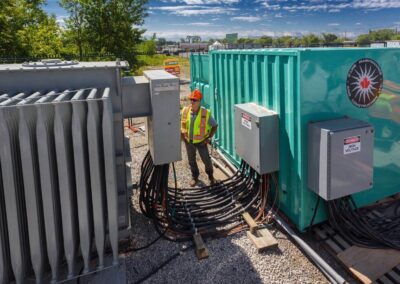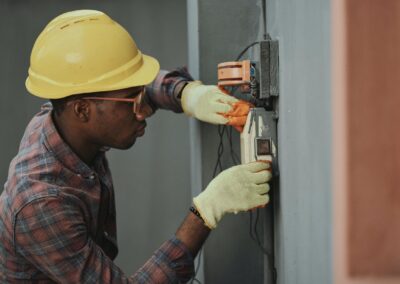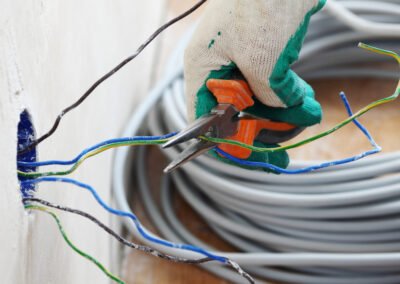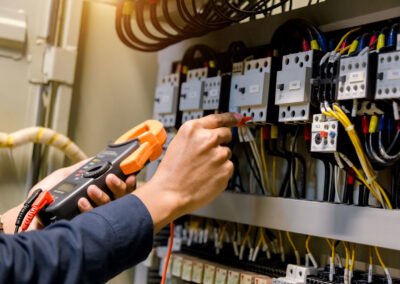Mobile Commercial Wiring, North York
Though electrical wiring in a residential facility is a fairly straightforward procedure, wiring for a commercial property is usually more complex, and requires the expertise of a skilled and knowledgeable electrician.
Request InformationSchedule Service
Mobile Commercial Wiring, North York
A good rule of thumb when completing renovations or any electrical project is to hire a licensed electrical contractor, who can ensure that the work is being completed safely and in compliance with the Electrical Safety Authority’s (ESA) electrical code. Regardless of whether it is on a residential or commercial property, electrical wiring can be a complex project which requires the expertise of a knowledgeable electrician. For commercial properties specifically, there are three different types of electrical wiring methods – busways, raceways and conductors, and cable assemblies.
Busways
A busway is an enclosed raceway with factory-mounted busbars. There are typically two main types of busway configurations which are compatible with insulated or bare conductors – feeder style or plug in style. An advantage to using the busway method is that it is more compact in size than multiple conduits, and is available in a variety of ampere ratings ranging from 60 to 4,000 A. In addition, the total voltage drop with the application of busways is less impactful.
Compared to other electrical wiring methods, a disadvantage of busways is a higher installation cost, and the limited space for bus plugs depending on the property’s layout. In addition, busways may be susceptible to failure due to water leaks within the property.
Raceways and Conductors
A commonly used electrical wiring method is the raceway and conductor method. The use of raceways and conductors usually involves a conduit/tube with multiple insulated phase and an equipment grounding conductor. The most common type of conductors are THHN/THWN (thermoplastic high heat-resistant nylon jacket/thermoplastic heat and water-resistant nylon jacket) or XHHW (XLPE high heat-resistant and water-resistant) in copper or aluminum. Aluminum is typically used for feeders, while copper is used for branch circuits.
An advantage of raceways and conductors is that it allows for changes in circuit configuration, and raceways can be easily used for remodelling projects. On the other hand, some disadvantages are high installation costs, and a complex installation process due to more rigid routing requirements.
Cable Assemblies
Another common type of commercial electrical wiring is a cable assembly. Cable assemblies consist of multiple conductors (both neutral and insulated phase) with a bare and/or insulated equipment grounding conductor. A bare grounding conductor will need to be wrapped and enclosed in either a metallic or non-metallic sheath. Cable assemblies can be custom ordered, and usually come with THHN/THWN or XHHW-2 (copper or aluminum) conductors.
A few advantages of using cable assemblies is a lower installation cost, quicker installation time and flexibility on cable routing. On the other hand, a disadvantage is that changes in circuit configuration are not possible once installation is complete, and that more planning is required during the configuration and cable procurement stages.
Though these three commercial wiring methods are most commonly used, there may be other alternative methods available. The actual design and installation process can vary depending on the commercial property’s needs and specifications. Here at Made Electric, we can guide you through all possible wiring methods and advise you on the best configuration for your commercial property. Don’t hesitate to contact MADE ELECTRIC today! We are an ESA licensed company with years of experience, and we provide quality service in both commercial and residential areas. Our team operates within North York and the GTA, and we are committed to helping meet all of your needs.
Frequently Asked Questions (FAQs)
How does commercial electrical rewiring differ from residential electrical wiring?
While most residential projects require single phase power, commercial wiring typically uses 3-phase power. Residential electricians can work on electrical systems which are smaller than commercial systems, with a voltage as high as 240V, while commercial electricians work on wiring systems which are much larger and complex.
Which electrical wiring method is best for my commercial property?
The three main methods for electrical wiring in commercial spaces are raceways and conductors, busways and cable assemblies. If you are unsure of which method is best for your property, don’t hesitate to contact us and we can advise and guide you through the installation process.
Are there other types of wiring methods for commercial properties?
The three main methods for wiring commercial properties (raceways and conductors, busways and cable assemblies) are the most commonly used methods in industry. However, alternate configurations are possible, and we will work with you to find a custom configuration that suits your property best.




